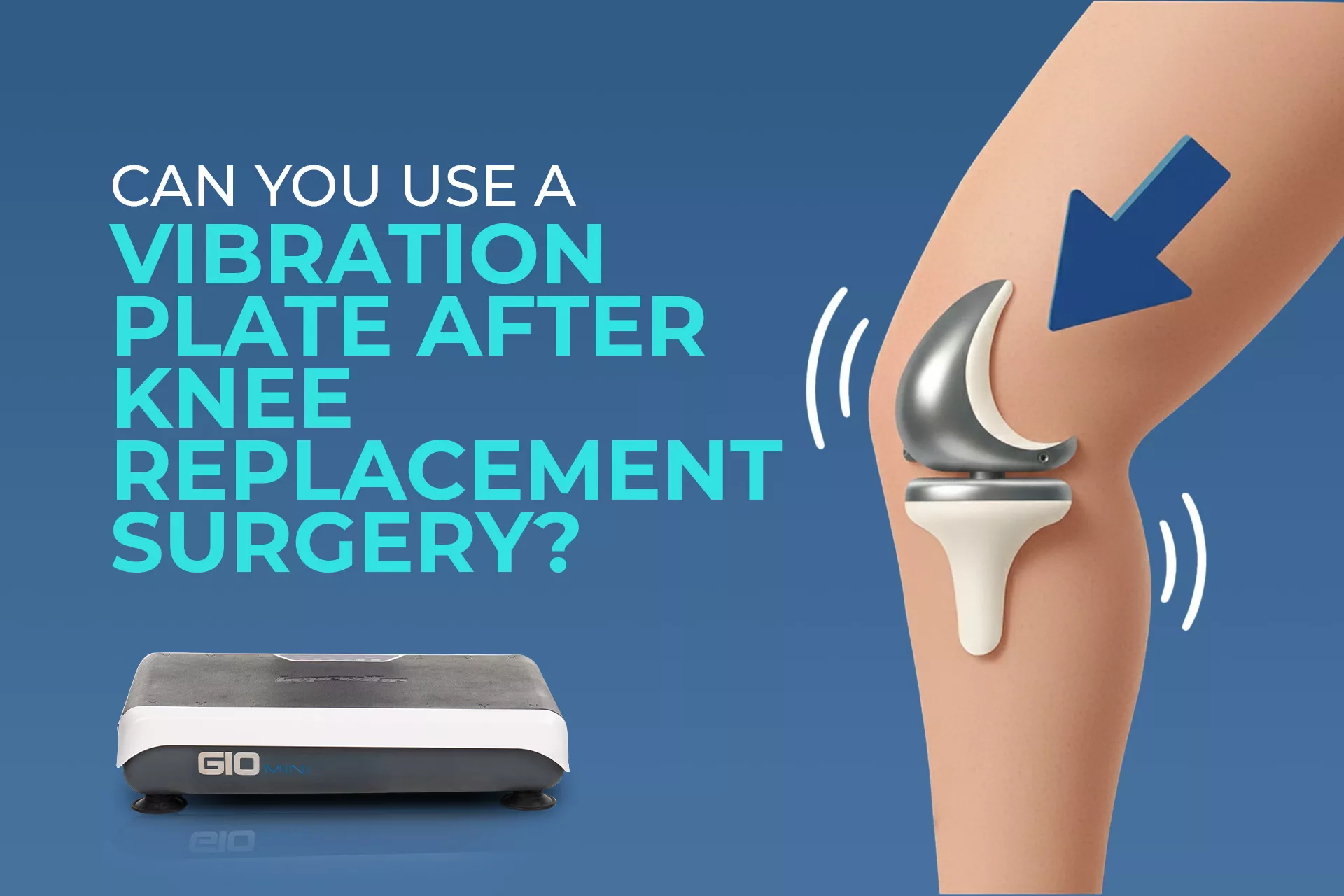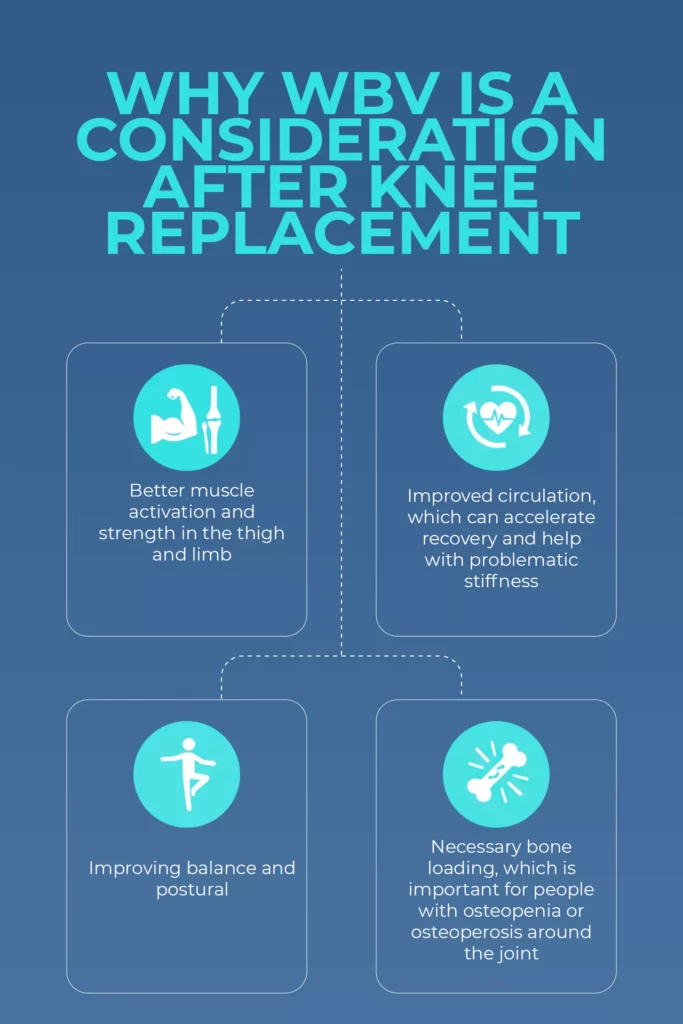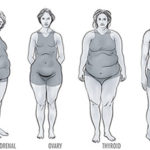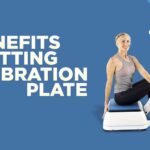
Yes, many people can safely use a Vibration Plate as part of their recovery from knee replacement surgery, but only after the surgical wound has healed, the implant is stable, and a surgeon or physiotherapist has formally signed off.
Start with low settings, short sessions, and external support (wall, platform stand etc…) for balance.
When it recommended to be cautious with WBV:
In these stages, standard postoperative protocols and basic physiotherapy take priority.
This is especially important if you have other medical conditions (e.g., cardiovascular disease, osteoporosis, DVT risk) or a complex surgical history, where vibration parameters may need careful adjustment.
Below is a list of people who should consider Whole Body Vibration (WBV).

Who can benefit from this vibration therapy and knee rehab guide.
Post-Knee Replacement Surgery Patients who want to:
Caregivers, Family, and Physiotherapy Clinics:
Whole Body Vibration (WBV) should only be used with medical clearance, safe settings, and a slow, gradual progression—and can sometimes be done seated or with support to reduce intensity and fall risk.
A Vibration Plate is a mechanical platform that oscillates up and down, sending controlled vibration through your body while you stand, sit, or exercise on it.
The vibration places a rapid force (G-force) on your body, causing your muscles to contract rapidly in response, usually 30 to 50 times per second.
These contractions can help improve strength, circulation, balance, and flexibility in less time compared with traditional workouts.
Using a Vibration Plate regularly can help support mobility and muscle tone, especially when paired with bodyweight resistance exercises on the platform.
There are two main types:
One side goes up while the other goes down, similar to walking.
Many people describe this as a more “natural” rocking or tilting motion.
The whole plate moves straight up and down,
which can feel more “buzzy” or like jumping on two feet
With either style, the effects are the same:
Emerging research suggests that, once your knee has healed to a certain extent, and you have medical clearance, adding WBV to a standard rehab program may help with:

Key reasons whole body vibration is considered after knee replacement surgery.
For example: a randomized controlled trial in osteopenic patients after total knee arthroplasty found that WBV, used alongside usual care, improved pain, muscle strength, knee function, and bone density over six months compared with exercise alone.
However, there is an important caveat: Vibration therapy is a tool to support rehab, not a magic gadget that replaces it.
It should always:
Recovery is not one big block; it has phases, and WBV fits differently into each.
There are clear situations where you should not use a Vibration Plate (or should only consider it under specialist supervision in a clinic setting).

Sometimes the right move is to pause and check if vibration therapy is appropriate.
These include:
Clinical WBV trials and rehab protocols routinely exclude patients with these kinds of conditions precisely to minimise risk.
Because of this, your surgeon and/or physiotherapist must be involved before you start.
Ask them explicitly about Whole Body Vibration (WBV) as part of your post-knee replacement plan and share any other diagnoses (cardiac, vascular, neurological, cancer, or bone health).
A common fear is that a Vibration Plate will “shake the implant loose” or accelerate wear in the new joint.
Current clinical research does not support this when WBV is used appropriately:
In practice, safety comes down to how you use the platform:
You should also know what to expect—and what to watch for:
Typical/acceptable sensations
Warning signs—stop and seek advice if you notice:
If any of these occur, stop using the machine and contact your surgeon or physio.
These symptoms may be unrelated to WBV, but they are not sensations to “push through” on an injured knee.
Once your surgeon and physiotherapist have cleared you, the next question is usually “How long should I stay on it, and how often?”
The short answer: most people do well with short, focused sessions, building up gradually under professional guidance rather than pushing limits.
Across vibration research in knee pain, osteoporosis, and knee osteoarthritis, many protocols and technical briefs cluster around short daily sessions of about 10 minutes, or 10–20 minutes with breaks, a few times per week.
For someone using a Vibration Plate after knee replacement, keeping sessions on the shorter side is sensible because:
For home use after knee replacement, a prudent ceiling is often around 10 minutes of total vibration time per session, and sometimes less at the beginning.
The examples below are conservative starting points, not prescriptions.
Your actual plan should be written or adjusted by your doctor or physiotherapist, who can factor in your surgery date, balance, bone health, and other conditions.
Weeks 1–2 on WBV (after you’ve been cleared to start):
Each session:
Focus:
Weeks 3–6 (if the early weeks are well tolerated):
Still 2–3 sessions per week, or at most 3–4 if your physio agrees and you’re responding well.
Gradually progress one variable at a time:
There is no single “perfect” time of day, but a few practical guidelines help most people:
Morning or earlier in the day
Start with avoiding very late-night sessions
Avoid when you are exhausted or in peak pain

Hypervibe whole body vibration machines ready for use in a rehab or fitness studio.
Hypervibe is positioned to make those lower, rehab-friendly settings and resources easy to access and understand.
I have been using a G17 Pro from Hypervibe in my practice for over five years now. I have found it to be a very useful and effective tool in clinical practice, helping me to gain excellent results with patients under my care. The reason I chose the Hypervibe G17 ahead of other brands is that it is simply the best value machine on the market. It is a beautifully made unit with heavy-duty components, which will last for many years.
– Dr Orazio Trevisan
Sports and Functional Chiropractor
If you and your medical team decide that Whole Body Vibration (WBV) is appropriate, you don’t have to figure everything out on your own.
Download the Hypervibe Buyer Guide for a conservative, physio-informed way to introduce Whole Body Vibration after surgery.
Explore Hypervibe models designed with low starting settings ideal for people recovering from knee replacement or other knee surgery.
Yes, some people can safely use a Vibration Plate after knee replacement, but only once the wound has healed, the implant is stable, and your surgeon or physiotherapist has cleared it.
Clinical trials in osteopenic patients after total knee arthroplasty have found that low-frequency, low-amplitude Whole Body Vibration (WBV) improved pain, strength, and function over six months without implant problems.
Used at the right time and dose, a Vibration Plate can be a helpful add-on to standard rehab by boosting muscle activation, strength, and functional tests like sit-to-stand and walking.
It works best as part of a full program (physio exercises, walking, balance work), not as a stand-alone “fix.”
Studies in knee osteoarthritis and post-TKA patients using low-to-moderate intensity, supervised protocols have not reported serious joint or implant damage.
The risk rises when people push intensity or ignore pain, so you should stop if you feel sharp joint pain, new instability, or increased swelling, and discuss these symptoms with your surgeon or physio.
Most post-surgery and older adult protocols stick to short sessions—often up to about 10 minutes of total vibration time per session, broken into 1–3 minute bouts with rests, a few times per week.
Your physiotherapist should individualize this based on your surgery date, pain, swelling, balance, and overall conditioning.
For knee replacement recovery, you typically start with low frequency and low amplitude, a stable stance (knees slightly bent), and plenty of hand support, then progress gradually only if your knee tolerates it well.
For many people with knee osteoarthritis, Whole Body Vibration (WBV)—combined with exercises—can reduce pain and stiffness and improve strength and function compared with exercise alone.
A minority do not tolerate WBV well, so very short, low-intensity trials with clear stop rules (and physio guidance) are essential.
You should avoid a Vibration Plate if you have an unhealed incision or infection, suspected implant loosening, marked uncontrolled swelling, recent blood clots, unstable heart disease, severe dizziness/balance problems, or other serious medical instability unless a specialist explicitly approves it.
These conditions are routinely excluded from WBV trials to minimize risk, and your surgeon or physio should have the final say before you start or resume vibration training.

Updated on: 08.09.2021 The lymphatic system is involved not only...

Stress can make you gain weight – we’ve heard this...

Various theories exist to answer this question. As you will...

Both rebounding and jumping on a trampoline are excellent ways...

The health benefits of using vibration plates to burn fat...